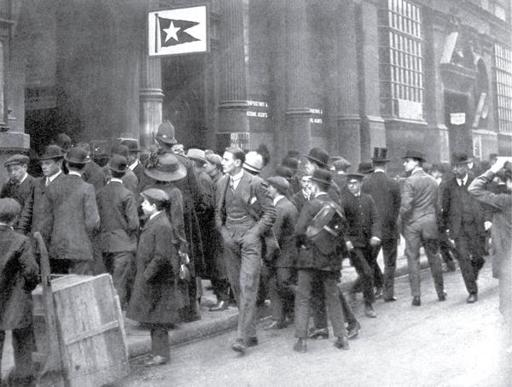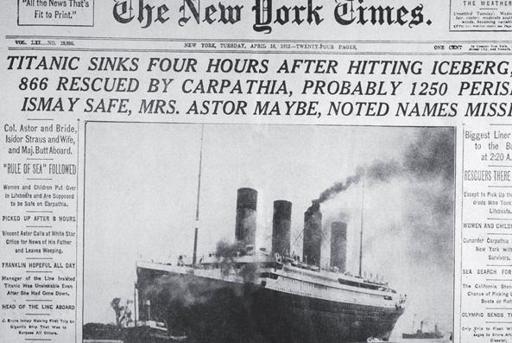Titanic (26 page)
Authors: Deborah Hopkinson

J. Bruce Ismay’s behavior was in stark contrast to that of Frankie’s mother and fireman Sam Collins, who reached out to help others as best they could. Ismay arrived on board the
Carpathia
in deep shock, asking only to be led to a quiet room. The
Carpathia
’s physician, Dr. Frank McGhee, gave Ismay his own cabin. Ismay made no effort to comfort the survivors or talk to families who had lost loved ones. Instead, he never left the doctor’s cabin. Jack Thayer was asked to visit him, as he and his parents had previously met Ismay on the
Titanic
.
“I immediately went down and as there was no answer to my knock, I went right in. He was seated, in his pajamas, on his bunk, staring straight ahead, shaking all over like a leaf,” said Jack. “I have never seen a man so completely wrecked. Nothing I could do or say brought any response.
“As I closed the door, he was still looking fixedly ahead.”
A year later, J. Bruce Ismay retired from business. Charges that he had saved himself at the expense of other passengers who had not survived dogged him all his life.
Charles Herbert Lightoller soon realized that he was the senior surviving officer. Captain E. J. Smith, Chief Officer Henry Wilde, and First Officer William Murdoch had perished. Passengers eagerly turned to Lightoller with questions. Was there any hope that their loved ones had been saved by some other ship?
He felt he had to tell them the truth. “What kindness was there in holding out a hope, knowing full well there was not even the shadow of hope? Cold comfort, and possibly cruel, but I could see no help for it.”
Stewardess Violet Jessop looked around for her friends and coworkers: “For our dear Tommy Andrews, for the good doctor, for the boys that made life aboard easier for us, for good friends in all departments. But they were all among the missing when the roll was called.”
Violet was grateful to the
Carpathia
’s crew for their kindness. “But there was little that could be done to comfort those who had lost and knew it should not have been.”
Lawrence Beesley was also thinking about the causes of the disaster. On Wednesday, after learning more about the ice warnings that had been sent to the
Titanic
before the collision, he sat down and wrote a letter to the editor of the
London Times
to tell the world what had happened.
He made a number of suggestions. Passenger ships crossing the Atlantic, he declared, should have enough space in their lifeboats for everyone on board.
And when they encounter a region of ice, wrote Beesley, ships should slow down.
(Preceding image)
Some of the
Titanic
’s lifeboats collected on the deck of the
Carpathia
.
(Preceding image)
Titanic
crew members pose in their life jackets after their rescue from the sinking ship.
“Sir: As one of few surviving Englishmen from the Titanic, which sank in mid-Atlantic on Monday morning last, I am asking you to lay before your readers a few facts concerning the disaster, in the hope that something may be done in the near future to ensure the safety of that portion of the traveling public who use the Atlantic highway for business or pleasure. . . .”
He then summarized several points — the
Titanic
was in a region of icebergs, it was running at a high rate of speed, there were not enough lifeboats. He then made the following simple suggestions:
“First, that no vessel should be allowed to leave a British port without sufficient boat and other accommodation to allow each passenger and member of the crew a seat; and that at the time of booking this fact should be pointed out to a passenger, and the number of the seat in the particular boat allotted to him then.
“Second, that as soon as is practicable after sailing each passenger should go through boat drill in company with the crew assigned to his boat.
“Third, that each passenger boat engaged in the Transatlantic service should be instructed to slow down a few knots when in the iceberg region, and should be fitted with an efficient searchlight.”

(Preceding image)
An anxious crowd gathers outside the London offices of the White Star Line, seeking news of the
Titanic
.
“The final docking in New York at Pier No. 54 North River, when all our friends and relations learned the truth about the extent of the loss, was the last nerve-shattering blow for many people . . . it marked the end of all hope.”
— Jack Thayer
On Tuesday morning, April 16, the headline on the front page of the
New York Times
broke the first news of the tragedy: “Titanic Sinks Four Hours After Hitting Iceberg.”
The
Time
s had gotten hold of wireless telegraph reports of the
Titanic
’s distress signals on Monday night. A new age of immediate media coverage was ushered in; the reputation of the
New York Times
as a major national newspaper grew, thanks to its early breaking of the story and coverage of the event.
By the time the
Carpathia
docked in New York on Thursday evening, April 18, intense interest in the disaster had spread worldwide. Newspapers issued special editions. White Star offices were crowded with people eager for news. The flags of all ships in New York Harbor were flown at half mast.
As the
Carpathia
glided toward Pier 54, she was surrounded by tugs. Reporters shouted out questions. More than 30,000 people waited in the rain, huddled under black umbrellas. Police had strung ropes to allow the survivors to pass. The usual customs inspections didn’t take place.
Souvenir hunters were already out in full force. On Thursday night, people stole oars and equipment from the
Titanic
’s lifeboats, which had been unloaded from the
Carpathia
. But interest in
Titanic
memorabilia had begun even earlier. James and Mabel Fenwick, a honeymoon couple on board the
Carpathia
, discovered a hardtack biscuit in a
Titanic
lifeboat and kept it, passing it down as a family keepsake.
Colonel Archibald Gracie regretted not keeping his life belt. After moving from Collapsible B into Lifeboat 12, he huddled under a steamer rug with other passengers before reaching the rescue ship.
“My life-belt was wet and uncomfortable and I threw it overboard . . . I regret I did not preserve it as a relic,” said Gracie.
Perhaps he should have. Genuine souvenirs of the
Titanic
have only increased in value over time. Christie’s auction house has sold a brass name plate from one of the
Titanic
’s lifeboats for $60,000, while just a fragment from a life belt has fetched more than $11,000.
(Preceding image)
The April 16, 1912, headline of the
New York Times
announces the sinking of the
Titanic
.






